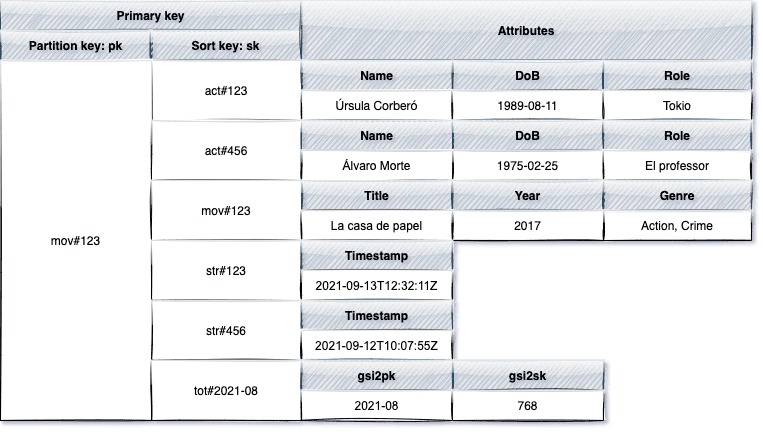Table Of Content

Once you have defined all your access patterns, you can design your primary and secondary keys. This is inherently an iterative process as there are often several viable options when selecting an entity’s keys. TypeDORM is an ORM built from the ground up using TypeScript to provide an easy entry point when doing complex, highly relational data modeling in DynamoDB.
Get all surveys
In DynamoDB, relationships are modeled within the data structure itself, eliminating the need for external table schemas or queries. You can’t use the JOIN operation to combine multiple tables, like you can in a relational database. Nor can you use aggregations like count, sum, min, or max to condense a large number of records.
Modeling relationships in the data
AWS AppSync is a flexible data API allowing you to connect to new or existing data sources in the cloud. It provides a fully-compliant GraphQl API that makes it easier for developers to build applications and interact comfortably with the data they need. With AppSync, you are not limited to interacting with data in a single way.
What this article is NOT about

If traffic patterns are unknown or you prefer to have capacity managed automatically, choose on-demand. To learn more about the capacity modes, visit the documentation page. Here, each Order belongs to a Customer, and both the tables imply the relationship by the customer_id. This article is intended for developers with a foundational understanding of databases, who are looking to deepen their practical knowledge of DynamoDB. I aim to equip you with the right tools to build efficient and cost-effective software, whether for your next pet project or the big feature you’re about to work on. We add a check to the resolver mapping template that only allows a student to listen for registrations changes on their student ID.
Migrate from SQL Server to Amazon DynamoDB with data transformation using a staging table Amazon Web Services - AWS Blog
Migrate from SQL Server to Amazon DynamoDB with data transformation using a staging table Amazon Web Services.
Posted: Fri, 29 Dec 2023 08:00:00 GMT [source]
The DynamoDB Single-Table Design Process
Telling people that most services can use a single table teaches that a DynamoDB table isn’t directly comparable to a relational database table. Users dig a little deeper and realize they need to focus on access patterns first, rather than an abstracted, normalized version of their data. They learn the key strategies for modeling NoSQL data stores to optimize performance. The Spring Data model is often used for accessing databases. Implementing the data access layer of your application without Spring Data and instead using the higher-level programming interface provided by the AWS SDK for Java has some advantages. For example, you can create a dedicated project for data access, allowing you to not only use this library in your Spring Boot applications but also in other plain Java code.
Data modeling with NoSQL Workbench for Amazon DynamoDB Amazon Web Services - AWS Blog
Data modeling with NoSQL Workbench for Amazon DynamoDB Amazon Web Services.
Posted: Mon, 27 Apr 2020 07:00:00 GMT [source]
DynamoDB focuses on being ultra-performant at OLTP queries and wants you to use other, purpose-built databases for OLAP. To do this, you'll need to get your data from DynamoDB into another system. At the end of this section, we'll also do a quick look at some other, smaller benefits of single-table design.
Our access patterns

Further, DynamoDB has made a number of improvements that reduce this argument even further. In 2018, DynamoDB announced adaptive capacity, which spreads your provisioning capacity across your table to the partitions that need it most. If managing your capacity is a burden, you can switch to on-demand mode and only pay for the resources you need. There are three functional reasons to use single-table design with DynamoDB, plus one non-functional, bonus reason.
DynamoDB looks like a hash map after all, so same principles apply here as well. Designing a good DynamoDB table is basically picking the right partition and sort keys. Under the hood, you can imagine a GSI creating an entirely separate Dynamo table with these new indices.
Determining data access requirements
But some datasets are smaller and more mutable, and they have different needs. These entities will be important in your data warehouse for joining with other, larger, event-like tables to give color to the events. Because these entities are mutable, we want our data warehouse to be regularly updated with the current version. Data warehouses don’t do well with random updates, so it’s usually better to export a full, updated table to load into your system.
Conversely, DynamoDB isn’t great at online analytical processing (OLAP) operations. These operations don’t need high throughput or low latency, but they do need to efficiently scan large amounts of data and perform computation. That said, I think this argument is a small factor in my consideration.
If you believe your model could be helpful to the community, you can add it to this directory by submitting a pull request to this repo. After merging pull request, it will appear here after some time. "Single-Table Examples Library" is a curated directory of approved DynamoDB designs which might help you understand modeling by analyzing examples. They can also serve you as a reference point when trying to implement your own models.
For that reason, we subtract Question ID from a very large number. You can use the OneTable CLI to apply your schema and populate your database with test data. The CLI applies discrete changes to your database via “migrations”.
This is where the power of a Global Secondary Index becomes apparent. A GSI allows us to remap the PK and SK values across our entire table. In other words, it provides an alternative way to organize and access our data, opening up a ton of possibilities. In our scenario, where entities like "Area," "Network," and "Device" coexist, we leverage DynamoDB's Single Table Design to seamlessly organize and retrieve this interconnected data.
For example, if you are calculating the summary, you should mark the already processed data. The other option, because this repetition of the call is rare, is to ignore the problem. This is acceptable if the data is more informative and does not have to be absolutely correct. The downside of this pattern is that each read demands two access to the database. First, to get the appropriate version and then for the actual read.

No comments:
Post a Comment